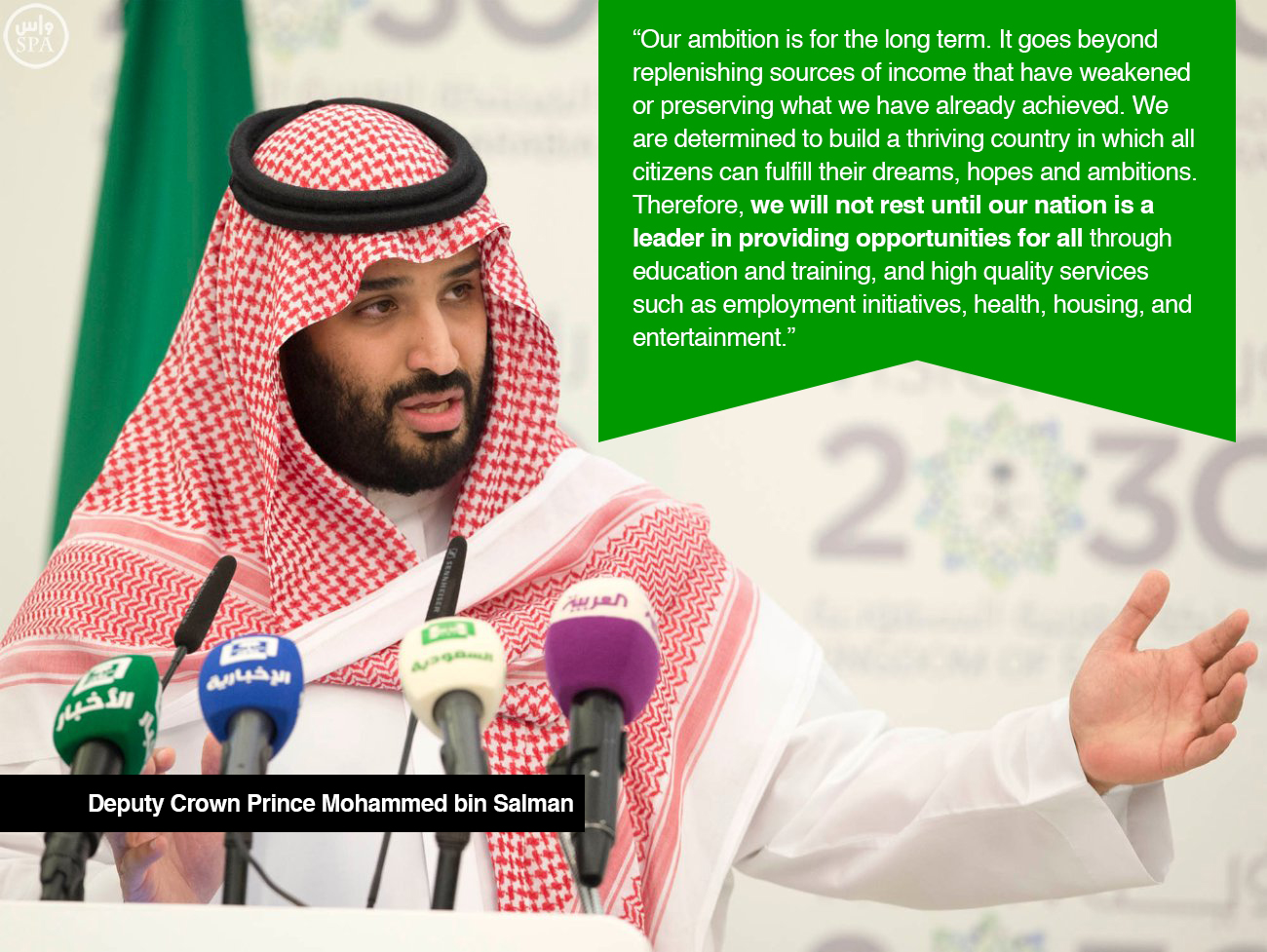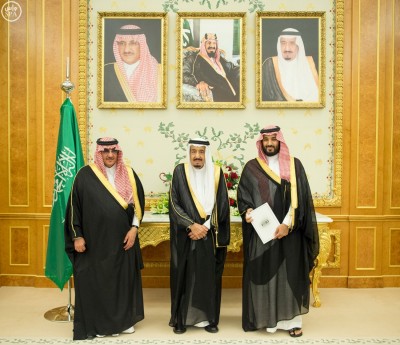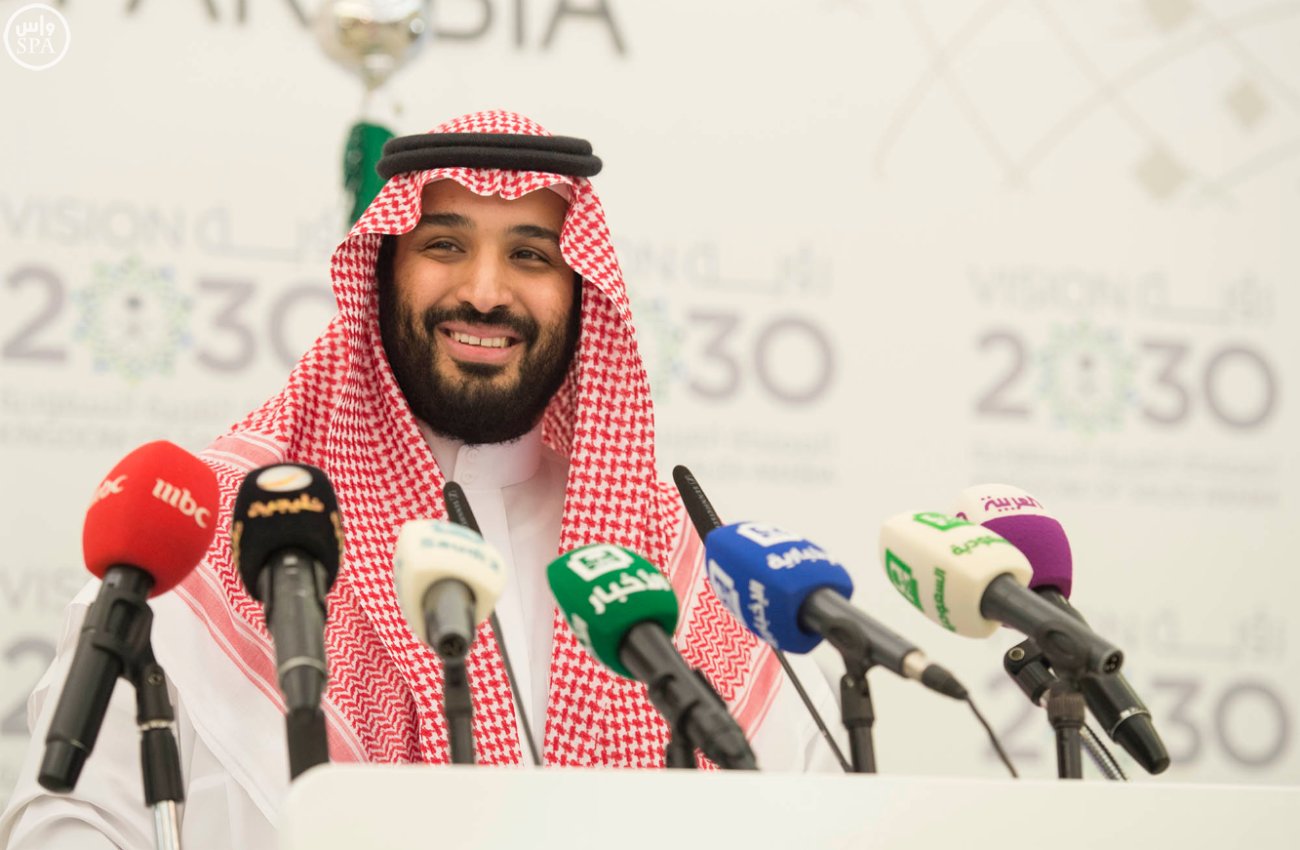While Saudi Arabia’s Vision 2030 was formally endorsed by the Saudi Council of Ministers and published on April 25, 2016, anticipation about the plan had been building for months. McKinsey & Company’s 165-page Moving Saudi Arabia’s Economy Beyond Oil in December 2015 confirmed the depth of the analysis underway within the Saudi government while Deputy Crown Prince Mohamed Bin Salman’s interviews with The Economist in January and Bloomberg in early April foreshadowed some of the major changes being contemplated.
By the time the text of the document was made available countless analysts and commentators had weighed in on a potential Saudi Aramco IPO and possible establishment of a ‘$2 trillion’ Saudi Public Investment Fund (PIF). After the Vision 2030 details were released these themes continued to dominate the discussion along with mention of other aspects of the plan such as potential ‘green-cards’ for non-Saudis, development of a domestic military production capacity, grand plans for an expanded tourism sector and a re-invigorated drive to develop renewable energy sources.
Given the extraordinary scope of the Vision 2030 plan along with Mohamed Bin Salman’s observation in Al-Arabiya that “the kingdom can live in 2020 without any dependence on oil,” it’s not surprising these catchy, big-ticket items crowded the headlines.
In all the IPO and PIF reporting, however, a fundamentally important aspect of the Vision 2030 process has been largely overlooked.
First, let’s understand what the Vision 2030 document is. It’s a startling ambitious framework for a profound overhaul of not only the Saudi economy but significant chunks of Saudi society.
The plan lays out a mind-boggling list of goals across three ‘Pillars’ of Saudi life. These Pillars are labeled ‘A Vibrant Society’; ‘A Thriving Economy’ and; ‘An Ambitious Nation.’ Every proposed reform listed under these Pillars comes with a goal and some of those with the specific metric to measure the success or failure of that goal.
Here are some of the 30 stated goals to be achieved by 2030 (unless otherwise noted):
-Increase non-oil government revenue from $43.5 billion to $270 billion;
-Increase the ratio of individuals exercising at least once a week from 13% of population to 40%;
-Raise Saudi Arabia’s global ranking in the Logistics Performance Index from 49 to 25;
-By 2020 80 percent of parents should be engaged in school activities and the learning process of their children;
-Raise Saudi Arabia’s ranking on the E-Government Survey Index from its current position of 36 to be among the top five nations;
-Increase household spending on cultural and entertainment activities inside the Kingdom from the current level 2.9% to 6%;
Yes, these are all from the same document.
In addition, actual implementation of most of the Vision 2030 goals will be accomplished through 13 ‘programs’ the details of which have yet to be announced. They will be rolled out over the next four to six weeks.
In fact, of the 7 ‘programs’ that fall under the ‘Thriving Economy’ Pillar and are of particular interest to the international business community and potential foreign investors, six have yet to be launched. These include the Saudi Aramco Transformation Program, the Public Investment Fund Restructuring Program, the National Transformation Program and the Strategic Partnerships Program. In short, they don’t exist yet.
Which brings us back to the actual Vision 2030 document. While a Saudi Aramco IPO is intriguing and a $2 trillion sovereign wealth fund a wonder to consider all the media noise they have created has caused many to miss the point of Vision 2030.
 Vision 2030 is a Saudi manifesto announcing a new relationship between the ruling monarchy and the Saudi people. Beginning in the introduction and threaded throughout is a promise of better, more efficient and more transparent government in all facets of Saudi society.
Vision 2030 is a Saudi manifesto announcing a new relationship between the ruling monarchy and the Saudi people. Beginning in the introduction and threaded throughout is a promise of better, more efficient and more transparent government in all facets of Saudi society.
Mohamed Bin Salman’s foreward to the plan states:
“We commit ourselves to providing world-class government services, which effectively and efficiently meet the needs of our citizens. Together we will continue building a better country, fulfilling our dream of prosperity and unlocking the talent, potential, and dedication of our young men and women.”
In a later section the document directly addresses the matter of transparency. “We shall have zero tolerance for all levels of corruption, whether administrative or financial. We will adopt leading international standards and administrative practices, helping us reach the highest levels of transparency and governance in all sectors.”
Previous planning missteps are even acknowledged in a section noting that the King Abdullah Financial District – a massive $8 billion project covering 1.6 million square meters in Riyadh – needed to be restructured as it was started, “without consideration of it’s economic feasibility.”
Throughout, the plan lays out of an array of economic and social goals by which government performance – good or bad — can be measured and assessed.
Of the 13 ‘programs’ mentioned above, six have been launched and five of those are directly related to achieving more responsive, efficient and transparent government.
Along with these programs, Vision 2030 is notable for the commitments made by the Saudi government. “Among our commitments” is the lead to 18 separate sections of the document. In greater detail than ever before, Vision 2030 lays out what Saudis should expect from their government. And, most importantly, these include measures by which you can grade the Government’s performance.
Vison 2030 is very much in keeping with the influx of more youthful and leadership across the GCC. Mohamed Bin Salman and the many new Saudi officials put in place over the last 15 months by King Salman are not promising a liberal democracy or a constitutional monarchy. They are, however, committing to good governance.
Along with recasting the government’s responsibilities to its people, Vision 2030 conveys a sense of shared enterprise with all Saudis. Early in the document it states that, “our real wealth lies in the ambition of our people and the potential of our younger generation. They are our nation’s pride and the architects of our future. We will never forget how, under tougher circumstances than today, our nation was forged by collective determination when the late King Abdulaziz Al-Saud — may Allah bless his soul — united the Kingdom. Our people will amaze the world again.” The theme of ‘we’re in this together’ is woven throughout the document.
Complementing the promise of good governance and the invitation to a shared enterprise is the call to strive for a grounded, moderate Islam. Islam and the Saudi responsibility to Islam’s holiest sites and the religious pilgrims who visit is a foundation of this document. Strikingly, though, the characterization of Islamic behavior refers to moderation, tolerance, excellence, discipline, equity and transparency. Significant attention is given to public goods such as increased exercise, more cultural and entertainment options, greater engagement in children’s’ education and increased home ownership. These are offered as the natural consequences of a moderate Islamic life well-lived.

Along with recasting the government’s responsibilities to its people, Vision 2030 conveys a sense of shared enterprise with all Saudis, writes Richard Wilson.
Saudi Ambassador to the United States, Abdullah Al-Saud, recently noted that the modern Saudi state is only 84 years old. The country was officially declared in 1932 after Abdulaziz Al-Saud (Ibn Saud) subdued its separate regions. In the life of the country one can point to a number of pivotal events: the first viable well from the Dammam Dome in 1938; the Nasser years in the 1960s; the assassination of King Faisal in 1975; the seizure of the Grand Mosque and the Iranian revolution in 1979; the extended decline of oil-prices in the 1980s; the first Gulf War and Desert Storm in 1991; the attacks of 9/11/2001; the Riyadh compound bombings in 2003. These all prompted Saudis to consider their circumstances, their choices and their future.
This is another watershed moment for Saudi Arabia that presents the opportunity to bind it’s government and its people in a common enterprise that will determine the future of the country.
It’s worth remembering that just 15 months ago the Council of Economic and Development Affairs didn’t exist, few people knew who Mohamed bin Salman was nor was he in a position to push through this Vision 2030, oil prices were just starting on their precipitous and prolonged downward swing, Saudi Arabia wasn’t experiencing billion-dollar budget deficits and McKinsey & Associates, BCG and others consultants hadn’t been called to Riyadh to huddle with Saudi officials and experts.
These circumstances have conspired, however, to compel the Saudi government to commit to a remarkably ambitious document that recasts the Saudi governing bargain and invites its citizens to help create a fundamentally re-made Saudi Arabia.
It could miss every goal it commits to and fail miserably. It could succeed beyond all expectations. It’s likely to be somewhere in between. Regardless, it changes everything in Saudi Arabia going forward. IPOs and PIFs, aside, don’t miss this point.










